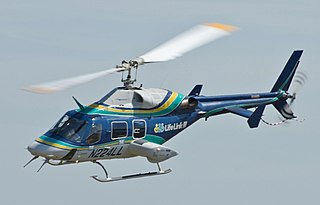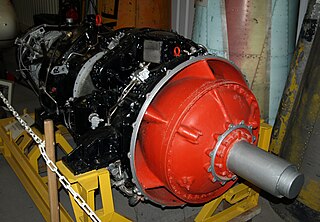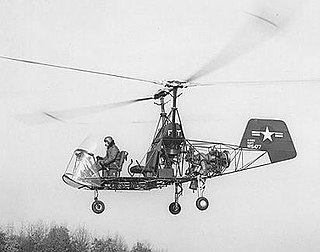Related Research Articles

The Bell 222 is an American twin-engine light helicopter built by Bell Helicopter. The Bell 230 is an improved development with different engines and other minor changes.

The Kamov Ka-26 is a Soviet light utility helicopter with co-axial rotors.

The Bell 47 is a single-rotor single-engine light helicopter manufactured by Bell Helicopter. It was based on the third Bell 30 prototype, which was the company's first helicopter designed by Arthur M. Young. The 47 became the first helicopter certified for civilian use on 8 March 1946. The first civilian delivery was made on 31 December 1946 to Helicopter Air Transport. More than 5,600 Bell 47s were produced, including those under license by Agusta in Italy, Kawasaki Heavy Industries in Japan, and Westland Aircraft in the United Kingdom. The Bell 47J Ranger is a modified version with a fully enclosed cabin and tail boom.

The Hiller OH-23 Raven is a two, three, or four place, military light observation helicopter based on the Hiller Model 360. The Model 360 was designated by the company as the UH-12, which was first flown in 1948. Initially it was two-place helicopter powered by a piston engine that entered service in the late 1940s, it went on to be a popular military and civilian light helicopter in the late 20th century. A Hiller UH-12 was the first helicopter to make a transcontinental flight across the USA, in 1949. It served in the Korean War with U.N. forces and also in Vietnam. It was an important early helicopter and was widely used internationally, and in U.K service it was called the Hiller HT Mk 1 and Mk 2; and the U.S. Navy also used it as the HTE-1 for training. It was sold commercially as the UH-12, though some military operators used the company designation. Some later models were designed for turbine power, and version with 4-seats was also sold. In Canada, UH-13E served the military as the CH-112 Nomad.

The Cessna CH-1 Skyhook is the only helicopter ever built by the Cessna Aircraft Company. It was the first helicopter to land on the summit of Pike's Peak and the last piston-engined helicopter to set the helicopter altitude record. The CH-1 had a single, two-bladed main rotor, and a front-mounted reciprocating engine which gave the aircraft a stable center of gravity (CG). Its semi-monocoque airframe greatly resembles its light airplane siblings built by Cessna. The CH-1 was named Skyhook for the civil market, similar to the marketing names used in the Cessna single engine airplane line, such as Skyhawk, Skylane and Skywagon. The United States Army designated the CH-1C as the YH-41 Seneca. While the CH-1 achieved several helicopter firsts and set a world record, it never became a commercial or military success.

The Changhe Z-11 is a light utility helicopter developed by Changhe Aircraft Industries Corporation (CAIC). According to the Changhe Aircraft Industries Corporation website, it is claimed to be the first indigenously-designed helicopter in China. However, it is largely based on the Eurocopter AS350 Écureuil.

The Piasecki VZ-8 Airgeep was a prototype vertical takeoff and landing (VTOL) aircraft developed by Piasecki Aircraft. The Airgeep was developed to fulfill a U.S. Army Transportation Research Command contract for a flying jeep in 1957. The flying jeep was envisioned to be smaller and easier to fly than a helicopter.

The Turbomeca Astazou is a highly successful series of turboprop and turboshaft engines, first run in 1957. The original version weighed 110 kg (243 lb) and developed 240 kW (320 shp) at 40,000 rpm. It was admitted for aviation service on May 29, 1961, after a 150-hour test run. The main developing engineer was G. Sporer. It was named after two summits of the Pyrenees.

The Agusta A.115 was a prototype helicopter flown in 1961 in Italy. It was essentially a Bell 47J-3 with an unclad, tubular tail boom, and powered by a Turbomeca Astazou II turboshaft engine. No production ensued.

The Agusta A.101 was a large prototype transport helicopter developed in Italy during the 1960s. Despite prospective orders from the Italian armed forces, no buyers emerged and the project was abandoned in 1971.

The Brantly B-2 is an American two-seat light helicopter produced by the Brantly Helicopter Corporation.

The Napier Eland is a British turboshaft or turboprop gas-turbine engine built by Napier & Son in the early 1950s. Production of the Eland ceased in 1961 when the Napier company was taken over by Rolls-Royce.

The Piaggio P.166 is an Italian twin-engine pusher-type utility aircraft developed by Piaggio Aero. The aircraft model name was Portofino, and is also known as Albatross in South African military service.

The Sikorsky S-60 helicopter, a prototype "flying crane", was derived from the S-56 in 1958. Proving to be underpowered, the development of the S-60 led to the larger, turbine-engined Sikorsky CH-54 Tarhe military transport helicopter, and its civil S-64 Skycrane variant, which were already on the drawing board by the time the sole example of the S-60 crashed on 3 April 1961.

The General Electric T64 is a free-turbine turboshaft engine that was originally developed for use on helicopters, but which was later used on fixed-wing aircraft as well. General Electric introduced the engine in 1964. The original engine design included technical innovations such as corrosion resistant and high-temperature coatings. The engine features a high overall pressure ratio, yielding a low specific fuel consumption for its time. Although the compressor is all-axial, like the earlier General Electric T58, the power turbine shaft is coaxial with the HP shaft and delivers power to the front of the engine, not rearwards. Fourteen compressor stages are required to deliver the required overall pressure ratio. Compressor handling is facilitated by 4 rows of variable stators. Unlike the T58, the power turbine has 2 stages.

The Honeywell T55 is a turboshaft engine used on American helicopters and fixed-wing aircraft since the 1950s, and in unlimited hydroplanes since the 1980s. As of 2021, more than 6,000 of these engines have been built. It is produced by Honeywell Aerospace, a division of Honeywell based in Scottsdale, Arizona, and was originally designed by the Turbine Engine Division of Lycoming Engines in Stratford, Connecticut, as a scaled-up version of the smaller Lycoming T53. The T55 serves as the engine on several major applications including the CH-47-Chinook, the Bell 309, and the Piper PA-48 Enforcer. The T55 also serves as the core of the Lycoming ALF 502 turbofan. Since the T55 was first developed, progressive increases in airflow, overall pressure ratio, and turbine inlet temperature have more than tripled the power output of the engine.

The Bell 47J Ranger is an American single-engine single-rotor light helicopter manufactured by Bell Helicopter. It was an executive variant of the highly successful Bell 47 and was the first helicopter to carry a United States president.

The Kaman K-225 is an American experimental helicopter developed by Kaman Aircraft. One example was modified to become the world's first gas turbine-powered helicopter.

The Vertical Hummingbird is an American helicopter, produced by Vertical Aviation Technologies of Sanford, Florida that was introduced in 1991. The aircraft is supplied as a kit for amateur construction.
The 'Sznycer SG-VI' was a single-engined three-seat utility helicopter designed and built in the United States and Canada in the late 1940s to the design of Bernard Sznycer, assisted by Selma Gottlieb and Engineering Products of Canada Ltd. (CanAmerican)
References
- ↑ "Picture News: Whirlybird Flying Crane". Popular Science. June 1958. p. 94.
- ↑ Publications, Alfred H. Saulniers Spinner. "Trivia: New Bedford makes helicopter history". New Bedford Standard-Times. Retrieved 2024-05-23.
- 1 2 3 4 5 6 Taylor 1961, p. 300
- ↑ Gunston 2005 , pp. 348, 448
- ↑ Hawkes Aviation Week May 7, 1956 , p. 50
- ↑ Hawkes Aviation Week May 7, 1956 , pp. 50–51
- ↑ Bass Flying October 1961 , pp. 32–33
- 1 2 Aviation Week June 12, 1961 , pp. 123, 125
- ↑ Aviation Week November 11, 1963 , p. 108
- ↑ Taylor 1967 , p. 193
- ↑ R.Simpson (1998). Airlife's Helicopter and Rotorcraft.
- ↑ Aviation Week June 12, 1961 , p. 123
- ↑ Taylor 1967 , pp. 193–194
- ↑ Taylor 1969 , pp. 243–244
- Bass, A. C. (August 1961). "Pilot Report: Omega BS-12D-1: A "Flying Crane" Helicopter". Flying . Vol. 69, no. 2. pp. 32–33, 85–88.
- Gunston, Bill (2005). World Encyclopedia of Aircraft Manufacturers (2nd ed.). Stroud, UK: Sutton Publishing. ISBN 0-7509-3981-8.
- Hawkes, Russell (May 7, 1956). "Omega Helicopter Designed to Cut Cost" . Aviation Week . Vol. 64, no. 19. pp. 50–51, 53, 55.
- "Omega's BS-12-D-1 Helicopter Certified; Other Versions Planned" . Aviation Week . Vol. 74, no. 24. June 12, 1961. pp. 123, 125.
- "Production of Omega BS-12-D3S Awaits Court Merger Approval" . Aviation Week . Vol. 79, no. 20. November 11, 1963. p. 108.
- Taylor, John W. R. (1961). Jane's All the World's Aircraft 1961–62. London: Sampson Low, Marston & Company, Ltd.
- Taylor, John W. R. (1967). Jane's All the World's Aircraft 1967–68. London: Sampson Low, Marston & Company, Ltd.
- Taylor, John W. R. (1969). Jane's All the World's Aircraft 1969–70. London: Sampson Low, Marston & Co., Ltd.